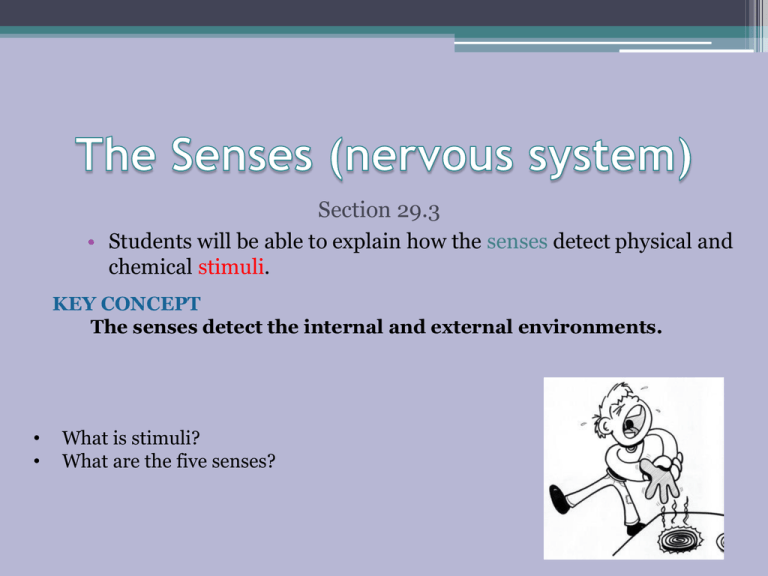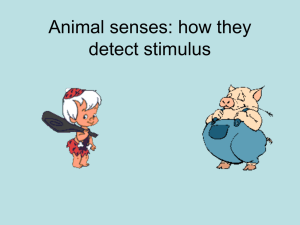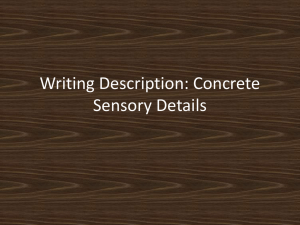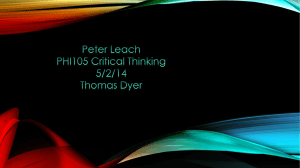The Senses - Ms Kim's Biology Class
advertisement

Section 29.3 • Students will be able to explain how the senses detect physical and chemical stimuli. KEY CONCEPT The senses detect the internal and external environments. • • What is stimuli? What are the five senses? Bellringer Write a short paragraph (3-4 sentences) explaining and giving examples of how drugs alter your brain chemistry. ▫ Use the vocabulary: addiction, and tolerance, Stimulants or depressants • Addiction: • physiological need for a substance ▫ Examples? What does the addiction lead a person to do? • Tolerance: • Takes larger doses of the drug to produce the same effect ▫ What is happening inside of their brain/body? • Stimulants: • are drugs that increase mental and physical functions (increase neurotransmitter and electrical signals) ▫ Examples? Effects? • Depressants: • Cause fewer action potentials and decrease neurotransmitter ▫ Examples? Effects ? • If I blindfolded you and place you in the back of the room would you reach the door? • Your sensory organs and your brain allow you to perceive stimuli as various sounds, sights, smells, and tastes Reactions to stimuli Ex: Eyes react to bright or dim light by changing the size of your pupils. Ex: When your skin feels cold ________________. Other examples? The senses help to maintain homeostasis. • Senses gather stimuli, and send it to the nervous system. • Nervous system responds to stimuli. ▫ Pupils shrink when too much light enters the eyes. ▫ Goose bumps when cold air touches skin. The senses detect physical and chemical stimuli. • Humans have specialized sensory organs that detect external stimuli. The information these organs collect helps to make up the five senses: ▫ ▫ ▫ ▫ ▫ Vision Hearing Touch Taste Smell Vision • The eye contributes to vision • Humans rely on vision more than any of the other senses • Eye contains about 70% of all the sensory receptors in the body • Depends on the amount of light available “I can’t believe my eyes!” Vision • Specialized cells called rods and cones are the photorecpetors. • Rod cells: detect light intensity and are used in black and white vision. • Cone cells: detect color. • Rod cells are sensitive to low amounts of light and need bright light to function. This is why you have a hard time seeing color when its dark. Hearing • The ear contributes to hearing. – Collects vibrations- sound waves- from the air, amplifies them, and converts them into nerve impulses that are interpreted in the brain as sounds. – Hair cells are specialized cells in the inner ear that contain mechanoreceptors that detect vibrations. – How do we rely on hearing? Taste and Smell • Taste and smell are closely related. • Your sense of taste is less sensitive when your nose is stuffed up. – Chemoreceptors detect chemicals dissolved in fluid. – In smell, small airborne chemicals enter the nose. – In taste, taste buds on tongue (bumps called papillae) are the receptors that detect the chemicals. – How do we rely on taste and smell? Touch, temperature, and pain • The skin senses touch. – detect pressure – detect damaged tissue (pain) – detect temperature – How do we rely on touch •Touch: mechanoreceptors that detect pressure, movement, and tension. •Temperature: thermoreceptors that detect heat and cold. •Pain: pain receptors that detect chemicals from damaged cells. The Stroop Effect Color Test (YOU WILL BE DOING MORE ON YOUR OWN WITH YOUR PARTNER) Directions: •2 colors will be shown to you •Say the COLOR of the word shown Red Orange • Remember say the COLOR of the word shown Red Gray The Stroop Effect • Psychologist John Stroop studied the processing of words and how these thought processes affected other mental tasks. • He found that the brain must override an automatic response when it receives conflicting information, or interference How much detail can you remember? What can you remember? • How many people were in the picture? • 4 • What was the man reading the newspaper wearing? • Hat, green jacket • How many of the men had sunglasses? • 2- one wearing them, one hanging on shirt • Describe the man on the left. • Tan jacket, white shirt with a blue design, had a beard, white, blue eyes Why can’t you remember some of the information? Our brain distinguishes between things that are important or not important when interacting with the environment. 3 composite sketches by three witnesses Write down the first picture you see in each optical illusion. MISTAKE????? Nine hidden ppl? Why didn’t you see more than one picture at first in the optical illusion? •Your brain is perceiving individual sensory stimuli as a meaningful whole.





